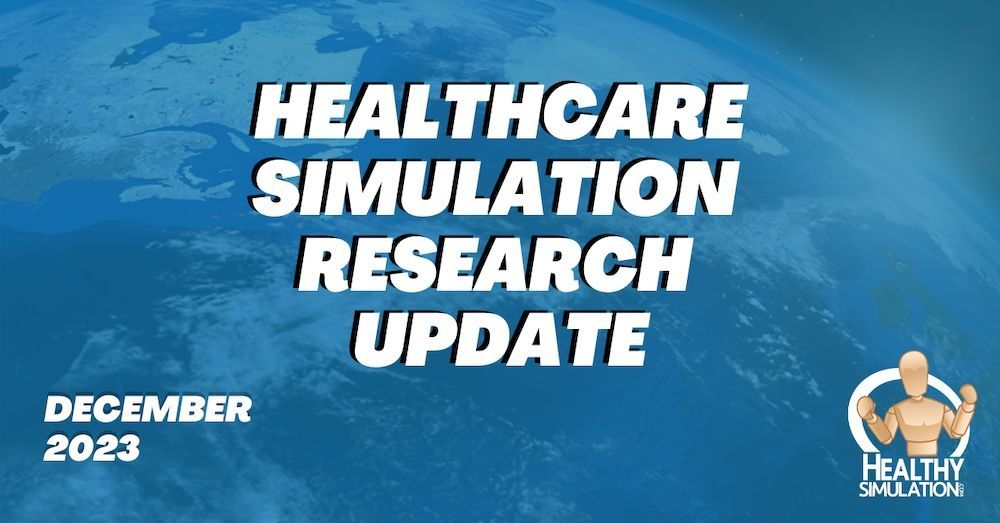Healthcare Simulation Research Update December 2023
The field of healthcare simulation has made tremendous strides forward over the past several decades. One way this revolution is made possible is through clinical simulation research being conducted across the globe. The journal Clinical Simulation in Nursing is constantly sharing updates that include article research reviews, more information on standards of best practice, research briefs, and overall innovations in medical simulation. This HealthySimulation.com article by Content Manager Teresa Gore, PhD, DNP, APRN, FNP-BC, CHSE-A, FSSH, FAAN provides an overview of the latest clinical simulation highlights as of December 2023 and explains how these updates impact the healthcare simulation community overall.
Mobile Healthcare Simulation Units: A Narrative Review: For healthcare professionals working and living in geographical isolation, there are few opportunities to maintain skills and knowledge, and to update themselves with recent advances in care compared to their citydwelling peers. It is known that within a short period and limited practice, clinical skills erode. A mobile healthcare simulation unit provides high-quality, technologicallyenhanced, convenient, and affordable training for healthcare professionals under expert supervision in any remote setting. The current narrative review was planned to summarise the outcomes and challenges related to developing and effectively utilising mobile healthcare simulation units as experienced globally. A literature search was performed on PubMed, Google Scholar and Cochrane databases for relevant articles published between 2000 and 2020, which resulted in 18 articles that were shortlisted and three major themes. The identification of common strengths, weaknesses and challenges will be a starting point for those engaged in planning and operating such a centre in any location.
Determining Current Approaches to the Evaluation of the Quality of Healthcare Simulation-Based Education Provision: A Scoping Review: Background: With an increase in simulation being used in healthcare education, there is a need to ensure the quality of simulation-based education is high. This scoping review was conducted to answer the question: What are the current approaches to the evaluation of the quality of health-care simulation-based education provision? Databases PubMed, Cochrane, ERIC, CINAHL and Medline were searched in March 2023 to retrieve peer-reviewed healthcare research and review articles written in the English language within the last 20 years. All data were extracted from six studies, themed and presented in the main text and in tabular form. Results identified two scoping reviews, one systematic review and three research articles were included. Three main themes were found: adherence to existing design frameworks, lack of validation of these frameworks and lack of evaluation frameworks, and a proposed evaluation framework. Many of the excluded articles focussed on gaining participant feedback to evaluate simulation activities, rather than evaluating the quality of the design and implementation of the simulation. Benchmarking of current United Kingdom (UK) healthcare simulation against UK and international simulation standards is required to increase its quality, therefore, an agreed UK template framework to evaluate simulation packages is recommended.
Sponsored Content:
Incorporating Healthcare Simulation Standards of Best Practice (HSSOBP) During Community Disaster Drills: Competent responses are imperative when disasters devastate communities, but current education does not sufficiently prepare nurses. While engaging in community-based simulations is beneficial, following best practice standards can be challenging. This paper demonstrates the alignment of Healthcare Simulation Standards of Best Practice (HSSOBP) with community-based interprofessional disaster simulations. Specific recommendations for each standard are included. Carefully aligning all aspects of a community-based drill with the HSSOBP should provide an optimal learning opportunity for nurses and facilitate gaining competency for disaster response. Faculty must advocate for student learning throughout the planning, design, and implementation of the event to provide an experience that meets both interprofessional goals and the unique needs of nursing learners. Well-designed experiences can prepare a future generation of nurses to appropriately respond when disaster strikes.
View the LEARN CE/CME Platform Webinar How to Implement INACSL’s Healthcare Simulation Standards of Best Practice Into Your Program to learn more!
Looking to the Future in Simulation: This is Karen Frith’s last column as editor for the Emerging Technologies Center. From Karen: “I began writing the column in the January 2019 issue of Nursing Education Perspectives with a focus on user-centered design. Academic nursing labs have come a long way from the era of static manikins, videos, and task trainers to the use of simulations with high-fidelity manikins. However, the cost of building, staffing, maintaining, and delivering quality education is high. Just the human simulators with high-fidelity functions alone can incur high initial purchase costs. Even with extended warranty options, ongoing maintenance costs are prohibitive for many nursing programs, making high-fidelity simulation centers and even manikins out of reach.
Significant technical support capabilities are required for the implementation of all simulation options. Faculty experts and simulation specialists are best qualified to recommend the new technology. Using a strategic approach, technologies can be selected that improve learning outcomes and that reasonably match institutional assets and constraints in terms of staffing, finance, and curricular fit. The payoff for well-planned simulation activities is having students competent and confident in making sound clinical judgments.
Sponsored Content:
Increasing Critical Thinking Opportunities Through Post-Conference Simulation in a Pediatric Baccalaureate Nursing Course: Traditional clinical experiences offer opportunities for nursing students to practice critical thinking. However, there are many limitations to planning these clinical experiences. The purpose of this educational activity is to incorporate post-conference simulation with traditional clinical to allow undergraduate nursing students expanded opportunities for enhancing critical thinking. The faculty created high-acuity simulation scenarios, which included a child experiencing respiratory, hematologic, neurological, or cardiovascular complications. After participating in the activity, students completed evaluation and reported increased confidence and preparedness to identify, think critically, and intervene in high-acuity situations.
A New Chapter in Clinical Simulation in Nursing: As I [Nicole Harder] reflect on the past 6 years as the Editor in Chief of Clinical Simulation in Nursing, it is with a mix of pride and nostalgia that I announce the transition to a new phase for our esteemed journal. It has been a privilege to serve as the steward of this publication since 2017, and I am delighted to pass the baton to a highly accomplished and respected academic, Professor Lisa McKenna. Effective January 1, 2024, Professor McKenna will assume the role of Editor in Chief for Clinical Simulation in Nursing.
The Clinical Simulation in Nursing journal has an impact factor of 2.6 for 2022 and 2.9 for a 5-year impact factor. Clinical simulation should be designed, developed, implemented, and evaluated based on the latest research and evidence-based practices that are supported by the Healthcare Simulation Standards of Best Practice. Whether someone is new to healthcare simulation and is looking to understand the fundamentals or is experienced and seeking the latest updates and research, INACSL can provide them with the support they need.
Learn More About Healthcare Simulation Research Journals!
Teresa Gore, PhD, DNP, APRN, FNP-BC, CHSE-A, FSSH, FAAN – Dr. Gore has experience in educating future nurses in the undergraduate and graduate nursing programs. Dr. Gore has a PhD in Adult Education, a DNP as a family nurse practitioner, and a certificate in Simulation Education. Dr. Gore is an innovative, compassionate educator and an expert in the field of healthcare simulation. In 2007l Teresa started her journey in healthcare simulation. She is involved in INACSL and SSH. She is a Past-President of INACSL and is a Certified Healthcare Simulation Educator Advanced (CHSE-A). In 2018, she was inducted as a Fellow in the American Academy of Nursing (FAAN). In 2021, she was inducted as a Fellow in the Society of Simulation in Healthcare Academy (FSSH) and selected as a Visionary Leader University of Alabama at Birmingham School of Nursing Alumni. During her career, Dr. Gore has led in the development and integration of simulation into all undergraduate clinical courses and started an OSCE program for APRN students. Her research interests and scholarly work focus on simulation, online course development and faculty development. She has numerous invited presentations nationally and internationally on simulation topics.
Sponsored Content:




















